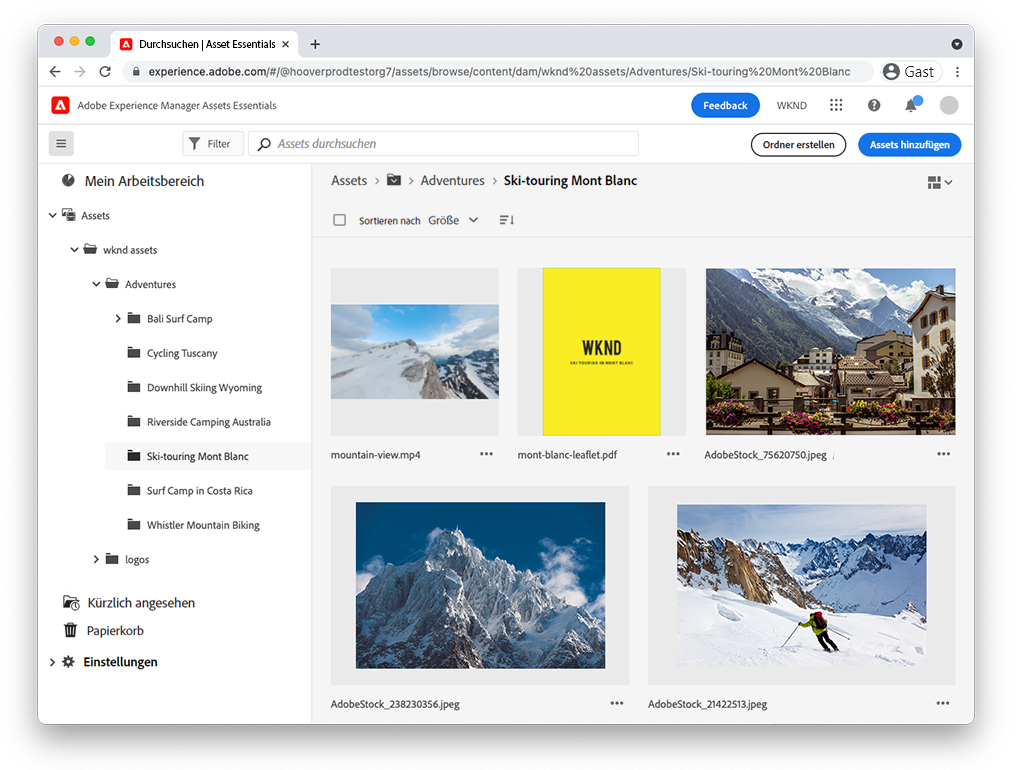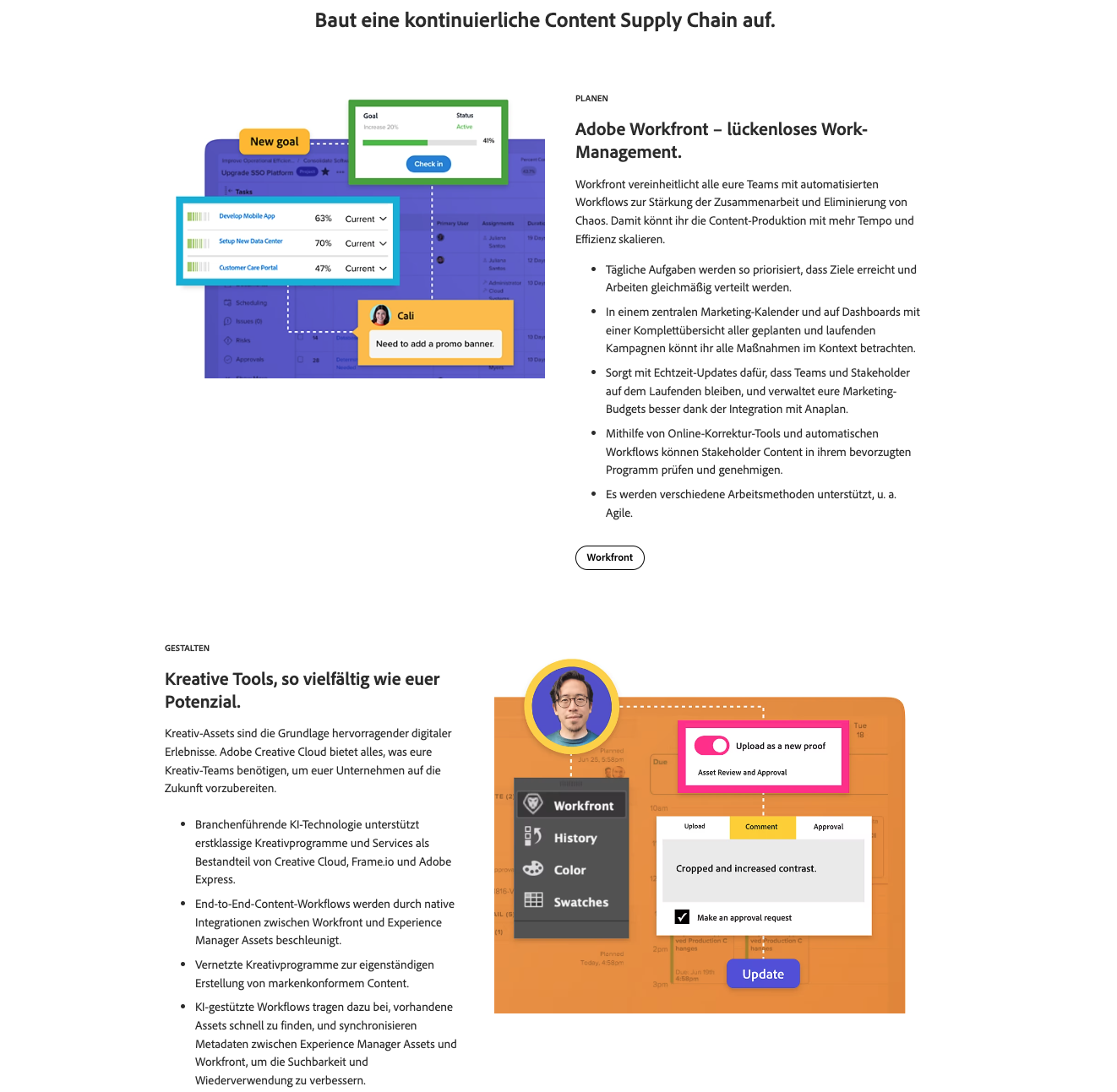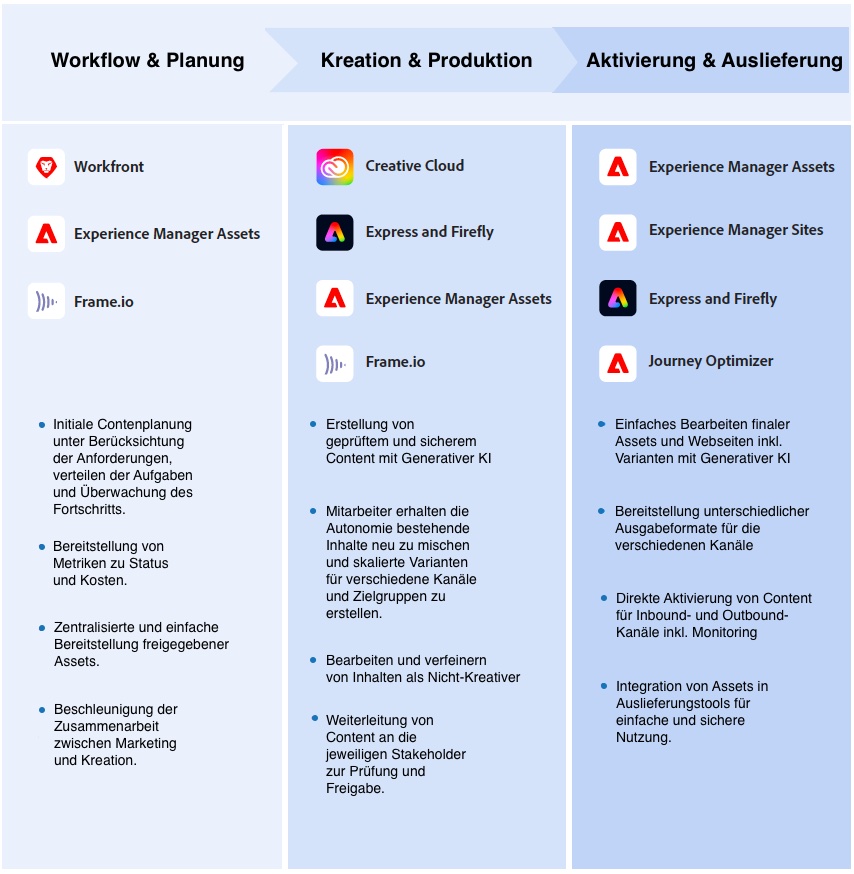At a time when content is king, the so-called content supply chain is increasingly becoming the focus of companies in a wide range of industries. The importance of high-quality and up-to-date content in the digital marketing world cannot be emphasized enough.
The study "Modern B2B purchasing" by ECC Cologne shows that more than 80% of B2B buyers first obtain information online and then predominantly buy online. Comprehensive, up-to-date and individualized content is now of great importance in order to meet this (digital) need for information and stand out from the crowd.

This is also reflected in the volume of data. According to a study by IDC, the volume of corporate content is expected to more than triple from an estimated 47 exabytes (one exabyte equals one million terabytes) in 2021 to 155 exabytes by 2026! It will therefore become increasingly important for companies in the future to establish the most efficient process possible for creating, delivering and monitoring relevant content that allows for the most personalized approach possible.
Challenges in content creation
There are a number of challenges when creating comprehensive and constantly updated content:
- The process of creating and delivering appropriate content takes too long.
- The cost of creating the different types of content that customers want is too high.
- Teams working on content are often isolated and cross-organizational collaboration is difficult.
- Business priorities are separated from execution.
- Creativity and quality suffer from massive workloads.
- Rapidly changing markets and customer expectations require faster responses through customized content.
In order to address these challenges as specifically as possible, it is now appropriate to take a strategic approach to content creation, content distribution, content analysis and content optimization. The content supply chain provides a sound management approach for this. But what exactly is the content supply chain all about and why is it so important for companies?
What is behind the Content Supply Chain (CSC)?
The content supply chain refers to the systematic process of creating, managing, delivering, monitoring and optimizing a wide variety of content such as images/graphics, videos, texts, brochures and much more, from the initial idea to the final publication and beyond. It's not just about producing content, but also about delivering it efficiently and effectively to the desired audience. This process can be considered analogous to the supply chain in manufacturing, where raw materials are transformed into finished products and delivered to consumers.
Adobe has been working on this topic for many years and defines the content supply chain as follows: "A CSC brings together people, tools and workflows to effectively plan, create, produce, deliver and measure the success of content. As customers demand ever higher quality in ever shorter timeframes, coupled with the complexity of multiple channels and formats, brands need to revolutionize the way they think about content."
Adobe divides the content supply chain into six steps or phases:

Phase 1: Brainstorming/briefing
Brainstorming is the creative core in which new concepts and topics are generated. Factors such as market research, customer feedback and technological developments play a role here in order to identify relevant and appealing content. This is often done in interdisciplinary teams that bring in different perspectives and expertise to gain a comprehensive understanding of the content needs.
The briefing follows the brainstorming and serves as a guideline for content creation. In this phase, the ideas found are transformed into concrete tasks and requirements. The briefing sets out clearly defined goals, target groups, messages and the desired tone of the content. It ensures clarity and consistency and makes sure that everyone involved - from editors to designers and developers - is on the same page.
Ideation and briefing are closely linked and play a central role in the content supply chain. A well-thought-out process in this initial phase can not only improve the quality of the end product, but also save resources and shorten time-to-market. Content planning tools - in the simplest case, this can also be an Excel sheet at the start - help to map this first phase of the CSC in the best possible way.
Phase 2: Creation
The creation phase occupies a central position within the content supply chain, as it marks the transition from conceptual ideas to tangible content. At this stage, the requirements and guidelines defined in the briefing are translated into actual content - be it in the form of text, graphics, videos or other digital formats.
The quality and consistency of the content created depends largely on the clarity and precision of the previous briefing. During the creation phase, various tools and technologies are used to optimize production and ensure that the content created meets standards and expectations.
Collaborative platforms and workflow tools such as Adobe Workfront enable teams to work together seamlessly, while advanced analytics tools help to check the effectiveness and relevance of the content. A carefully executed creation phase lays the foundation for success in subsequent phases of the content supply chain, ensuring that the content's message is both clear and effective.
Phase 3: Collaboration and review
The creation phase is followed by the crucial collaboration and review phase. The focus here is on the collaborative approach, where different team members, departments or external partners (stakeholders) are involved in the review process.
In this phase, content is checked for quality, accuracy and consistency to ensure that it meets the defined standards and objectives. Modern collaboration tools facilitate this process by enabling real-time feedback, version control and seamless communication between stakeholders. The review phase also ensures compliance with legal requirements and industry standards.
Missteps here can have costly consequences, both financially and for the company's reputation. A careful and systematic collaboration and review phase ensures the quality of the content (content governance) and creates the basis for successful publication and distribution.
Phase 4: Production
The production phase is a critical point at which the prepared content is finalized for publication and distribution. Here, the content created in the creation phase and revised in the collaboration and review phase is brought into a final format. This can include the rendering of a video, the formatting of a text or the finalization of graphic designs in different formats for different output channels.
Modern production tools and technologies, above all the Adobe Creative Cloud, are designed to speed up this process while ensuring the highest quality standards. Automation is playing an increasingly important role here due to the growing demand for a wide variety of assets, with AI now also increasingly ensuring greater efficiency. A smooth content production workflow can avoid bottlenecks and ensure that content can be delivered or handed over on time.
Phase 5: Distribution
The distribution phase, often referred to as the distribution phase, is the final and crucial step in the content supply chain, where the completed content is delivered to the desired audience via the appropriate channels. The effectiveness of this phase depends heavily on knowing the target audiences and choosing the right distribution channels, be it via social media, websites, email campaigns or other platforms.

The various assets are stored centrally in a Digital asset management system (DAM) and made accessible. Content delivery networks (CDNs) and other technologies ensure fast and reliable delivery, even with high user numbers or a global reach.
Phase 6: Analysis and optimization
Once the content has been successfully distributed, the final phase of the content supply chain begins with the analysis and optimization phase, which is also one of the most important. In this phase, data on the performance and engagement of the content is collected and evaluated in order to assess its effectiveness. Using advanced analytics tools, companies can measure KPIs such as click-through rates, dwell time, conversion rates and much more.
This feedback is invaluable as it not only provides insight into what content is resonating particularly well with audiences, but also where there is room for improvement. Based on these findings, adjustments can be made, be it in the form of content updates, the realignment of marketing strategies or the revision of target group approaches.
The optimization phase ensures that a company's content strategy is always dynamic and adapted to the constantly changing needs and preferences of the market. A continuous cycle of analysis and optimization allows companies to remain competitive in the fast-paced digital landscape and keep their content offering at the highest level.
The individual steps and their sequence may vary depending on the company and its requirements, but the basic concept remains the same: getting content from concept to consumer as efficiently and effectively as possible, as well as constantly monitoring the impact of the content and optimizing it where necessary. Efficient management of the content supply chain can help companies improve their content strategy, reduce costs and achieve better results in terms of engagement and conversion.
When does a content supply chain make sense?
The introduction of a content supply chain is naturally associated with corresponding expenses, both monetary and organizational. It should therefore be planned.
- Growing content volumes: As soon as a company produces a larger amount of content - be it for marketing, internal communication or customer service - managing this content can become a real challenge. This is where a structured content supply chain or a corresponding software solution can help.
- Multiple platforms and channels: When content is distributed across multiple platforms and channels, a coordinated strategy and ongoing monitoring become essential.
- Global presence: Companies that operate in several countries or regions often have to provide content in different languages or country variants, which can sometimes significantly increase the scope and complexity.
- Quality and compliance: Particularly in regulated industries where content accuracy and compliance are critical, a content supply chain with appropriate review and approval mechanisms is often essential. This is the only way to ensure the necessary quality of content and monitor compliance with guidelines and specifications (content governance). Adobe provides the tool Adobe Workfront workflow management software, which can be seamlessly linked to the Creative Cloud. This allows the necessary processes to be mapped within existing and familiar tools.

What advantages does a content supply chain offer?
Efficiency and scalability: A well-defined content supply chain enables companies to create, manage, distribute and monitor content more efficiently. This makes it easier to scale content production.
Quality assurance: Clear processes and review mechanisms in the supply chain ensure that content achieves the desired quality, is legally compliant and minimizes errors.
Targeted communication: A structured content strategy ensures that content is effectively targeted at the right audience for maximum impact.
Coherence and consistency: Brand messages and content remain consistent across all channels and platforms, which strengthens the brand image and builds trust with customers.
Analysis and optimization: With a well-thought-out content supply chain, companies can capture performance metrics and continuously optimize their content strategy based on this data. Here are some key figures from practice:
- Orvis reduced the time it takes to create project plans by 75%
- The creative team at JLL increased its output by 260% within two years
- T-Mobile increased campaign output by 47% without increasing headcount
- Asics reduced content waste by 30% by increasing asset reuse.
Steps to implement a CSC
To get the most benefit from implementing a CSC, the following steps should be considered:
Assess the current state: before you start building a content supply chain, you should analyze the current state of your content creation and distribution processes. What is working reliably? Where are there bottlenecks or challenges?
Define goals: Clarify what you want to achieve with your content strategy. Do you want to increase brand awareness, generate leads, improve customer service or pursue other specific goals?
Define team and responsibilities: Determine who in your organization is responsible for which aspects of content creation and management. This may include the roles of editors, designers, technicians, marketers and others.
Select technology and tools: Invest in the right technologies that support the entire content lifecycle - from content management systems (CMS) to analytics tools to content distribution platforms. Content supply chain tools such as Adobe GenStudio are now also available, allowing the entire process to be mapped seamlessly.

Establish processes and workflows: Define clear processes for creating, reviewing, approving and publishing content. This ensures that content always meets the desired standards and is produced efficiently.
Measurement and optimization: Implement metrics and analytics to measure the success of your content and identify areas for improvement. By measuring the ROI of your content, you can derive important insights for your content strategy.
Prerequisites for a successful content supply chain
Organizational readiness: An effective content supply chain often requires organizational change. The company should be prepared to face up to these changes and provide resources for their implementation.
Clear communication: Everyone involved should be clear about the goals, processes and responsibilities. This promotes smooth collaboration and prevents misunderstandings.
Technology infrastructure: Invest in the right technology and content tech stack to support the process. This can include CMS, digital asset management (DAM), analytics tools, collaboration platforms, workflow tools and more.
Continuous training: As technologies and best practices in the digital world are constantly evolving, it's important that you stay on the ball. The increasing use of AI in particular will bring enormous opportunities, but also changes.
Feedback culture: Encourage your team to give feedback and use it constructively to continuously improve the content supply chain.
Some facts and figures
- According to a Study by Gartner (2021), 67% of marketers plan to increase their investment in content management technologies in the next two years.
- According to the Content Marketing Institute companies produced an average of 300% more content in 2022 than in 2018. This increase underlines the need to implement effective content supply chain methods.
- HubSpot found that companies that have optimized their content supply chain see a 47% higher return on investment (ROI) in their content marketing efforts than those that have not.
- Forrester Research predicted that spending on content management systems (CMS) will rise to over $15 billion by 2023, driven by the need to manage more complex content supply chains.
The evolution of the content supply chain with integrated software tools
In the past, content was often created in isolation for specific channels or campaigns. Today, however, content needs to be cross-platform, consistent and high quality. This shift has led companies to rethink and reorganize their processes.
Modern content supply chains are increasingly using AI tools to personalize content, optimize its distribution and maximize ROI. One example is image recognition with automatic tagging and automated cropping depending on the respective output channel, which can significantly speed up the content creation process.
Adobe has developed a new approach called Adobe GenStudio for this purpose. This is a complete solution to accelerate and simplify your content supply chain with generative AI and intelligent automation.
Adobe GenStudio is a content supply chain tool that can be used to seamlessly manage the end-to-end content creation process. From strategy, ideation and creation to approvals, delivery and analysis. The integrated solution helps to create content at scale, get it to market faster, optimize performance and increase return on investment. The core of the solution is based on Adobe Creative Suite as the leading creative tool, which is intelligently linked with supplementary tools and technologies.
The content supply chain software Adobe GenStudio enables:
- Use generative AI (Adobe Firefly)to create content that is suitable and safe for commercial use.
- Use of familiar (creative) tools such as Photoshopto create content at scale.
- Use Adobe Firefly APIs to access different tools and platforms to accelerate workflows and automation.
- Utilize integrated workflowsto connect AI-generated content with key services for editing (Creative Cloud), collaboration and activation.
- Centralized delivery of approved content via AEM Assets for publication via a wide variety of channels and as a basis for individual customization per target group, country, etc.
- Distributed teams can respond to the specific requirements of channels, target groups and locations
- Faster content creation and delivery while maintaining brand standards and overall control.
- Plan, manage and track your content initiatives to optimize resources and budget.
- Efficient coordination between teams - from brief creation to creative ideation, review, approval and delivery.
- Transparent insights into content performance across multiple channels.

While the individual solutions within each pillar offer independent advantages, they are even more powerful when used together. Adobe GenStudio is based on the generative AI Adobe Firefly, which allows content to be created very easily, quickly and legally securely. Similarly, in Adobe Photoshop, for example, images can be added, removed or replaced using the Generative Fill function, all based on text input.
Whether it's creative teams creating original content or downstream marketers reassembling existing content to provide better personalization. With Adobe tools, teams can instantly turn ideas into creative content and assets. This allows the content creation process to scale and adapt faster and better than ever before.

Conclusion
The facts and figures illustrate how important an efficient content supply chain is for a company's success, especially in today's world. It is not just a question of quantity, but above all the quality and relevance of the content and how it is delivered to the audience. With the right understanding and the right tools, companies can optimize their content strategy and gain a clear competitive advantage.
The content supply chain is more than just a buzzword. It is a crucial factor for companies that want to be successful in the digital age. This requires investment in technology as well as in people and processes. However, those who act correctly here can secure significant competitive advantages. With Adobe GenStudio is an extremely powerful and flexible content supply chain solution that can seamlessly map the entire content process and builds on familiar and mostly existing tools such as the Creative Cloud with Photoshop as the central creative tool.
Anyone interested in learning more about content supply chain management should download the latest issue of eStrategy magazine. The magazine is available for free download at the following link: www.estrategy-magazin.de
Too much theory? At the SPIN Digital Experience Lab, initiated by TechDivision and Adobe, you can not only experience the latest Adobe tools and their interaction live, but also try them out for yourself - content supply chain in practice!
Further information and free registration are available at https://www.spin-dx.de/.
Do you have any questions?
Simply fill in the form opposite or send us an e-mail to anfragen (at) techdivision.com or call us on +49 8031 22105-0.
